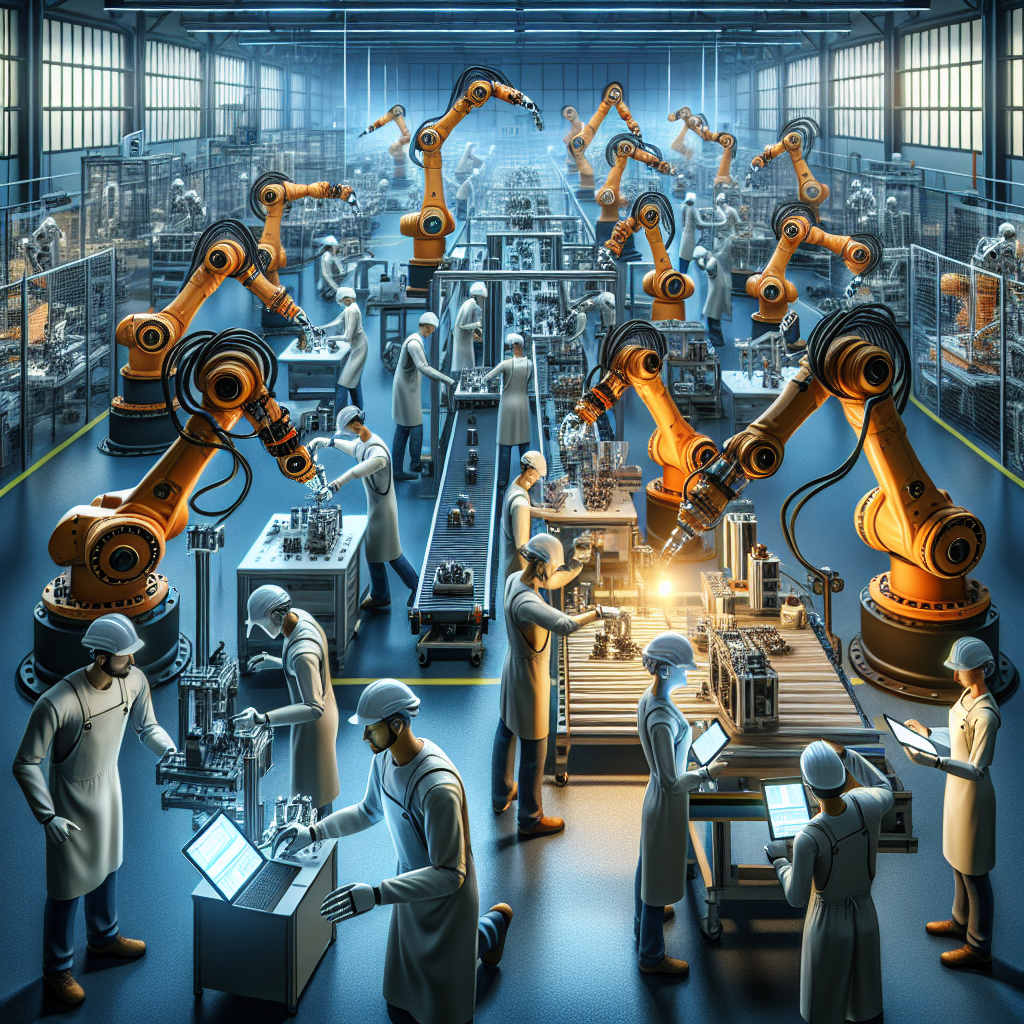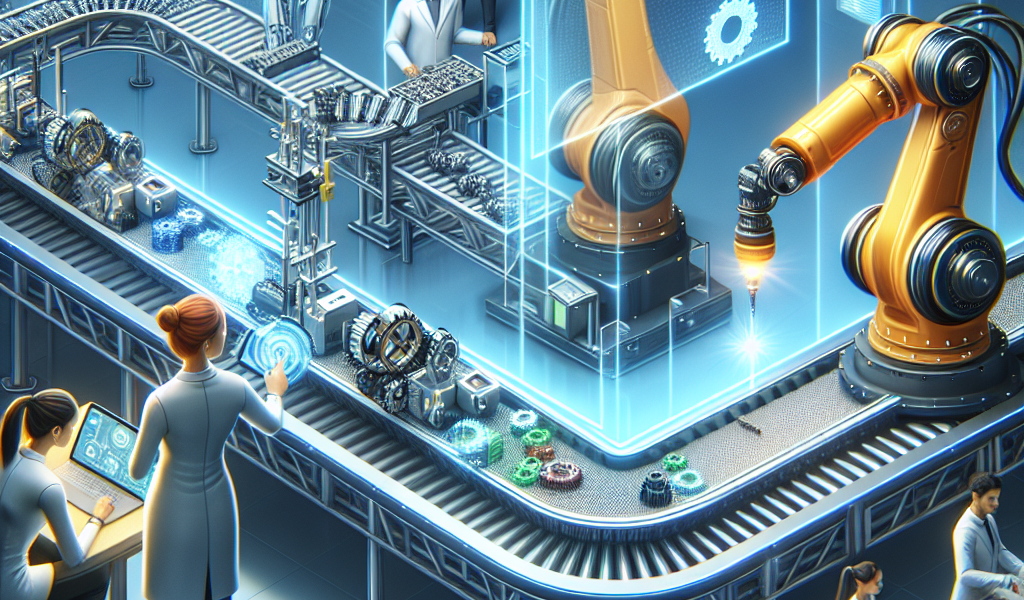-
Table of Contents
“Revolutionizing Efficiency: The Role of Robotics in Modern Manufacturing”
Introduction

The Role of Robotics in Modern Manufacturing
In the rapidly evolving landscape of modern manufacturing, robotics has emerged as a pivotal force driving efficiency, precision, and innovation. The integration of advanced robotic systems into manufacturing processes has revolutionized production lines, enabling companies to achieve unprecedented levels of productivity and quality. Robotics in manufacturing encompasses a wide array of applications, from assembly and welding to material handling and quality inspection. These automated systems not only enhance operational efficiency by performing repetitive and hazardous tasks with high accuracy but also offer the flexibility to adapt to varying production demands. As industries strive to meet the challenges of global competition and consumer expectations, the role of robotics in modern manufacturing continues to expand, fostering a new era of smart factories and reshaping the future of industrial production.
Enhancing Efficiency: How Robotics Revolutionize Production Lines
In the bustling world of modern manufacturing, the integration of robotics has become a game-changer, significantly enhancing efficiency and revolutionizing production lines. As industries strive to meet the ever-growing demands of consumers, the adoption of robotic technology has proven to be a pivotal move. This transformation is not just about replacing human labor but about creating a harmonious synergy between human skills and robotic precision.
To begin with, the introduction of robotics into manufacturing processes has led to remarkable improvements in productivity. Robots, with their ability to operate tirelessly around the clock, ensure that production lines can run continuously without the need for breaks. This constant operation significantly reduces downtime and increases output, allowing manufacturers to meet tight deadlines and maintain a steady supply chain. Moreover, robots are designed to perform repetitive tasks with unparalleled accuracy, minimizing the risk of human error and ensuring consistent product quality.
Transitioning from productivity to precision, robotics bring a level of accuracy that is difficult for human workers to achieve consistently. In industries where precision is paramount, such as electronics and automotive manufacturing, robots excel in tasks that require meticulous attention to detail. For instance, in the assembly of electronic components, even the slightest deviation can lead to product failure. Robots, equipped with advanced sensors and programming, can execute these tasks with exacting precision, ensuring that each component is placed correctly and functions as intended.
Furthermore, the versatility of robotics in manufacturing cannot be overstated. Modern robots are highly adaptable and can be programmed to perform a wide range of tasks, from welding and painting to packaging and quality inspection. This flexibility allows manufacturers to quickly reconfigure production lines to accommodate new products or changes in design, providing a significant competitive advantage in a fast-paced market. Additionally, collaborative robots, or cobots, are designed to work alongside human workers, enhancing their capabilities and allowing for a more dynamic and efficient workflow.
In addition to enhancing productivity and precision, robotics also play a crucial role in improving workplace safety. Manufacturing environments often involve hazardous tasks that can pose significant risks to human workers. By delegating these dangerous tasks to robots, manufacturers can reduce the incidence of workplace injuries and create a safer working environment. For example, robots can handle the lifting of heavy materials, exposure to harmful substances, and operation of high-temperature machinery, thereby protecting human workers from potential harm.
Moreover, the economic impact of robotics in manufacturing is profound. While the initial investment in robotic technology can be substantial, the long-term benefits far outweigh the costs. Increased efficiency and reduced labor costs lead to higher profit margins, enabling companies to reinvest in further technological advancements and innovation. This, in turn, drives economic growth and creates new job opportunities in areas such as robot maintenance, programming, and system integration.
As we look to the future, the role of robotics in manufacturing is set to expand even further. Advances in artificial intelligence and machine learning are paving the way for smarter, more autonomous robots capable of making real-time decisions and optimizing production processes. This evolution promises to unlock new levels of efficiency and innovation, ensuring that manufacturers can continue to meet the demands of an ever-changing global market.
In conclusion, the integration of robotics into modern manufacturing has revolutionized production lines by enhancing efficiency, precision, versatility, and safety. As technology continues to advance, the symbiotic relationship between human workers and robots will undoubtedly lead to even greater achievements, driving the industry forward and shaping the future of manufacturing.
Quality Control: The Impact of Robotics on Product Consistency
In the ever-evolving landscape of modern manufacturing, robotics has emerged as a pivotal force, particularly in the realm of quality control. The integration of robotic systems into production lines has revolutionized the way manufacturers ensure product consistency, leading to significant improvements in both efficiency and reliability. As we delve into the impact of robotics on product consistency, it becomes evident that these technological advancements are not just enhancing quality control but are also reshaping the entire manufacturing process.
To begin with, one of the most notable advantages of using robotics in quality control is the unparalleled precision they offer. Unlike human inspectors, robots are not susceptible to fatigue or human error, which can lead to inconsistencies in product inspection. Equipped with advanced sensors and machine learning algorithms, robotic systems can detect even the slightest deviations from the desired product specifications. This level of accuracy ensures that each product meets the stringent quality standards set by manufacturers, thereby reducing the likelihood of defective products reaching the market.
Moreover, the speed at which robots can operate is another critical factor contributing to improved product consistency. Traditional quality control methods often involve manual inspection, which can be time-consuming and labor-intensive. In contrast, robots can perform inspections at a much faster rate, allowing for real-time quality control without causing bottlenecks in the production process. This increased efficiency not only boosts overall productivity but also ensures that any defects are identified and addressed promptly, minimizing the risk of widespread quality issues.
In addition to speed and precision, the versatility of robotic systems plays a crucial role in enhancing product consistency. Modern robots can be programmed to handle a wide range of tasks, from simple visual inspections to complex measurements and testing procedures. This adaptability allows manufacturers to implement comprehensive quality control protocols that cover every aspect of the production process. By automating these tasks, manufacturers can maintain a consistent level of quality across different product lines and production batches, ensuring that customers receive products that meet their expectations every time.
Furthermore, the data-driven nature of robotic quality control systems provides valuable insights that can be used to further improve product consistency. Robots equipped with advanced data analytics capabilities can collect and analyze vast amounts of data during the inspection process. This data can then be used to identify patterns and trends, enabling manufacturers to pinpoint the root causes of any quality issues and implement corrective actions. Over time, this continuous feedback loop helps to refine production processes and enhance overall product quality.
While the benefits of robotics in quality control are undeniable, it is also important to acknowledge the challenges that come with their implementation. The initial investment in robotic systems can be substantial, and there may be a learning curve associated with integrating these technologies into existing production lines. However, the long-term gains in terms of improved product consistency, reduced waste, and increased customer satisfaction often outweigh these initial hurdles.
In conclusion, the role of robotics in modern manufacturing, particularly in quality control, cannot be overstated. By offering unparalleled precision, speed, versatility, and data-driven insights, robotic systems are transforming the way manufacturers ensure product consistency. As technology continues to advance, it is likely that the impact of robotics on quality control will only grow, paving the way for even greater innovations in the manufacturing industry.
Workforce Transformation: The Integration of Robotics and Human Labor
In recent years, the manufacturing industry has undergone a significant transformation, largely driven by the integration of robotics into the workforce. This shift has not only revolutionized production processes but also redefined the roles of human labor within the sector. As companies strive to remain competitive in an increasingly globalized market, the synergy between robotics and human workers has become a focal point of innovation and efficiency.
One of the most notable impacts of robotics in manufacturing is the enhancement of productivity. Robots, with their precision and ability to operate tirelessly, have taken over repetitive and physically demanding tasks. This has allowed human workers to focus on more complex and creative aspects of production. For instance, while robots handle assembly line duties with remarkable accuracy, human employees are now more involved in quality control, problem-solving, and process optimization. This division of labor not only boosts overall efficiency but also leads to higher-quality products.
Moreover, the integration of robotics has significantly improved workplace safety. Manufacturing environments often involve hazardous conditions, such as exposure to heavy machinery, toxic substances, and extreme temperatures. By delegating dangerous tasks to robots, companies can reduce the risk of workplace injuries and ensure a safer environment for their employees. This shift not only protects workers but also reduces costs associated with workplace accidents and insurance claims.
However, the rise of robotics in manufacturing has also sparked concerns about job displacement. Many fear that the increasing reliance on automation could lead to widespread unemployment. While it is true that some jobs have been rendered obsolete by robots, the overall impact on employment is more nuanced. The introduction of robotics has created new job opportunities in areas such as robot maintenance, programming, and systems management. Additionally, the demand for skilled workers who can collaborate with and oversee robotic systems has surged, leading to a shift in the types of skills that are valued in the manufacturing industry.
To address these changes, companies and educational institutions are investing in retraining programs to equip workers with the necessary skills to thrive in a technologically advanced workplace. By providing training in robotics, programming, and other relevant fields, these initiatives aim to bridge the gap between traditional manufacturing roles and the new demands of a robot-integrated workforce. This proactive approach not only helps workers adapt to the evolving landscape but also ensures that companies have access to a pool of skilled talent.
Furthermore, the collaboration between humans and robots has led to the development of “cobots” or collaborative robots. Unlike traditional industrial robots that operate in isolation, cobots are designed to work alongside human workers, enhancing their capabilities rather than replacing them. These robots are equipped with advanced sensors and safety features that allow them to interact safely and efficiently with humans. The use of cobots has been particularly beneficial in tasks that require a combination of human dexterity and robotic precision, such as intricate assembly work and material handling.
In conclusion, the integration of robotics into the manufacturing workforce has brought about a profound transformation, characterized by increased productivity, improved safety, and the creation of new job opportunities. While concerns about job displacement are valid, the overall impact of robotics on employment is complex and multifaceted. By investing in retraining programs and embracing collaborative technologies like cobots, the manufacturing industry can harness the full potential of robotics while ensuring a harmonious and productive relationship between human workers and their robotic counterparts. As this synergy continues to evolve, it promises to shape the future of manufacturing in ways that benefit both businesses and employees alike.
Conclusion
The role of robotics in modern manufacturing is pivotal, driving significant advancements in efficiency, precision, and scalability. Robotics technology has revolutionized production lines by automating repetitive tasks, reducing human error, and enhancing product quality. This integration has led to increased productivity, cost savings, and the ability to meet high consumer demands with consistent output. Furthermore, robotics enables manufacturers to adapt quickly to market changes and customize products with greater flexibility. As technology continues to evolve, the reliance on robotics in manufacturing is expected to grow, further transforming the industry and setting new standards for innovation and competitiveness.




